Numerical Simulation of the Smoke Recirculation Behavior in Street Canyons with Different Aspect Ratios and Cross-Wind Conditions
Abstract
:1. Introduction
2. Modeling
2.1. Physical Model Configuration
2.2. Grid Sensitivity
3. Results and Discussion
3.1. Smoke Recirculation Behavior in Street Canyons
3.2. The Critical Smoke Recirculation Velocity for Different Street Canyon Conditions
3.3. Correlation of the Smoke Critical Recirculation Velocity for Different Street Canyon Aspect Ratio Conditions
4. Conclusions
- The smoke recirculation behavior inside the street canyon can be divided into two different regimes for different aspect ratio (n = H/W) conditions. The transition of smoke from the “fully recirculation stage” (smoke recirculation in the entire canyon) to the “semi recirculation stage” (smoke recirculation in the middle-upper part of the canyon) will take place when the aspect ratio of the street canyon is n = 1.
- For street canyons with higher buildings and narrower streets, the critical velocity for the presence of smoke recirculation is found to be lower; however, this critical velocity will increase with decreasing building height and increasing street width. The critical smoke recirculation velocity is found to be almost constant at 2.84 m/s when the aspect ratio of the street canyon is n = 1.
- A piecewise function with a distinguishing point at n = 1 is proposed for the normalized critical velocity Vc* (i.e., the critical velocity Vc upon the standard critical velocity for an ideal street canyon Vc,0). Within the “fully recirculation stage” and “semi recirculation stage”, the critical velocity decreases linearly with the increasing street canyon aspect ratio.
Author Contributions
Funding
Institutional Review Board Statement
Informed Consent Statement
Data Availability Statement
Conflicts of Interest
References
- Vardoulakis, S.; Fisher, B.E.A.; Pericleous, K.; Gonzalez-Flesca, N. Modelling air quality in street canyons: A review. Atmos. Environ. 2003, 37, 155–182. [Google Scholar] [CrossRef] [Green Version]
- Ai, Z.T.; Mak, C.M. CFD simulation of flow in a long street canyon under a perpendicular wind direction: Evaluation of three computational settings. Build. Environ. 2017, 114, 293–306. [Google Scholar] [CrossRef]
- Kikumoto, H.; Ooka, R. A numerical study of air pollutant dispersion with bimolecular chemical reactions in an urban street canyon using large-eddy simulation. Atmos. Environ. 2012, 54, 456–464. [Google Scholar] [CrossRef]
- Chan, T.L.; Dong, G.; Leung, C.W.; Cheung, C.S.; Hung, W.T. Validation of a two-dimensional pollutant dispersion model in an isolated street canyon. Atmos. Environ. 2002, 36, 861–872. [Google Scholar] [CrossRef]
- Gromke, C.; Buccolieri, R.; Sabatino, S.D.; Ruck, B. Dispersion study in a street canyon with tree planting by means of wind tunnel and numerical investigations–Evaluation of CFD data with experimental data. Atmos. Environ. 2008, 42, 8640–8650. [Google Scholar] [CrossRef]
- Tao, C.-F.; Wang, K.; Liu, Q.; He, P.-X. A Simulation Investigation of Fire Smoke Behavior above Urban Street Canyon. Procedia Eng. 2018, 211, 681–688. [Google Scholar] [CrossRef]
- Wang, Y.; Zhou, Y.; Zuo, J.; Rameezdeen, R. A Computational Fluid Dynamic (CFD) Simulation of PM10 Dispersion Caused by Rail Transit Construction Activity: A Real Urban Street Canyon Model. Int. J. Environ. Res. Public Health 2018, 15, 482. [Google Scholar] [CrossRef] [Green Version]
- Li, X.X.; Britter, R.E.; Norford, L.K.; Koh, T.Y.; Entekhabi, D. Flow and Pollutant Transport in Urban Street Canyons of Different Aspect Ratios with Ground Heating: Large-Eddy Simulation. Bound-Lay Meteorol. 2012, 142, 289–304. [Google Scholar] [CrossRef] [Green Version]
- Oka, Y.; Sugawa, O.; Imamura, T. Correlation of temperature rise and velocity along an inclined fire plume axis in crosswinds. Fire Saf. J. 2008, 43, 391–400. [Google Scholar] [CrossRef]
- Assimakopoulos, V.D.; ApSimon, H.M.; Moussiopoulos, N. A numerical study of atmospheric pollutant dispersion in different two-dimensional street canyon configurations. Atmos. Environ. 2003, 37, 4037–4049. [Google Scholar] [CrossRef]
- Chan, A.T.; So, E.S.P.; Samad, S.C. Strategic guidelines for street canyon geometry to achieve sustainable street air quality. Atmos. Environ. 2001, 35, 4089–4098. [Google Scholar] [CrossRef]
- Kim, J.-J.; Baik, J.-J. Urban street-canyon flows with bottom heating. Atmos. Environ. 2001, 35, 3395–3404. [Google Scholar] [CrossRef]
- Wang, P.; Zhao, D.; Wang, W.; Mu, H.; Cai, G.; Liao, C. Thermal Effect on Pollutant Dispersion in an Urban Street Canyon. Int. J. Environ. Res. 2011, 5, 813–820. [Google Scholar] [CrossRef]
- Cai, X.M. Effects of differential wall heating in street canyons on dispersion and ventilation characteristics of a passive scalar. Atmos. Environ. 2012, 51, 268–277. [Google Scholar] [CrossRef]
- Memon, R.A.; Leung, D.Y.C.; Liu, C.H. Effects of building aspect ratio and wind speed on air temperatures in urban-like street canyons. Build. Environ. 2010, 45, 176–188. [Google Scholar] [CrossRef]
- Kim, J.J.; Baik, J.J. Effects of Street-Bottom and Building-Roof Heating on Flow in Three-Dimensional Street Canyons. Adv. Atmos. Sci. 2010, 27, 513–527. [Google Scholar] [CrossRef]
- Nazarian, N.; Kleissl, J. Realistic solar heating in urban areas: Air exchange and street-canyon ventilation. Build. Environ. 2016, 95, 75–93. [Google Scholar] [CrossRef] [Green Version]
- Tan, Z.J.; Dong, J.L.; Xiao, Y.M.; Tu, J.Y. A numerical study of diurnally varying surface temperature on flow patterns and pollutant dispersion in street canyons. Atmos. Environ. 2015, 104, 217–227. [Google Scholar] [CrossRef]
- Lin, Y.; Ichinose, T.; Yamao, Y.; Mouri, H. Wind velocity and temperature fields under different surface heating conditions in a street canyon in wind tunnel experiments. Build. Environ. 2020, 168, 106500. [Google Scholar] [CrossRef]
- Hu, L.H.; Huo, R.; Yang, D. Large eddy simulation of fire-induced buoyancy driven plume dispersion in an urban street canyon under perpendicular wind flow. J. Hazard. Mater. 2009, 166, 394–406. [Google Scholar] [CrossRef]
- Hu, L.H.; Xu, Y.; Zhu, W.; Wu, L.; Tang, F.; Lu, K.H. Large eddy simulation of pollutant gas dispersion with buoyancy ejected from building into an urban street canyon. J. Hazard. Mater. 2011, 192, 940–948. [Google Scholar] [CrossRef] [PubMed]
- Pesic, D.J.; Blagojevic, M.D.; Glisovic, S.M. The model of air pollution generated by fire chemical accident in an urban street canyon. Transp. Res. D-Transp. Environ. 2011, 16, 321–326. [Google Scholar] [CrossRef]
- Pesic, D.J.; Blagojevic, M.D.J.; Zivkovic, N.V. Simulation of wind-driven dispersion of fire pollutants in a street canyon using FDS. Environ. Sci. Pollut. Res. 2014, 21, 1270–1284. [Google Scholar] [CrossRef] [PubMed]
- Pesic, D.J.; Zigar, D.N.; Anghel, I.; Glisovic, S.M. Large Eddy Simulation of wind flow impact on fire-induced indoor and outdoor air pollution in an idealized street canyon. J. Wind. Eng. Ind. Aerodyn. 2016, 155, 89–99. [Google Scholar] [CrossRef]
- Wang, Z.L.; Lu, K.H.; Feng, L.; Tao, Y.; Wang, J.; Ding, Y.M.; Shi, C.L. Simulation on smoke re-circulation transition in an urban street canyon for different fire source locations with cross wind. Saf. Sci. 2020, 127, 104716. [Google Scholar] [CrossRef]
- Zhang, X.C.; Zhang, Z.J.; Su, G.K.; Tao, H.W.; Xu, W.H.; Hu, L.H. Buoyant wind-driven pollutant dispersion and recirculation behaviour in wedge-shaped roof urban street canyons. Environ. Sci. Pollut. Res. 2019, 26, 8289–8302. [Google Scholar] [CrossRef]
- Huang, Y.D.; Hou, R.W.; Liu, Z.Y.; Song, Y.; Cui, P.Y.; Kim, C.N. Effects of Wind Direction on the Airflow and Pollutant Dispersion inside a Long Street Canyon. Aerosol Air Qual. Res. 2019, 19, 1152–1171. [Google Scholar] [CrossRef]
- Cui, P.Y.; Zhang, J.H.; Wu, Y.P.; Zhang, Y.; Zhou, J.Z.; Luo, Y.; Huang, Y.D. Wind-tunnel measurements and LES simulations of air pollutant dispersion caused by fire-induced buoyancy plume inside two parallel street canyons. Process Saf. Environ. 2020, 140, 151–169. [Google Scholar] [CrossRef]
- Zhao, S.Z.; Yang, H.R.; Li, C.R.; Obadi, I.; Wang, F.; Lei, W.J.; Xu, T.T.; Weng, M.C. Numerical investigation on fire-induced indoor and outdoor air pollutant dispersion in an idealized urban street canyon. Build Simul.-China 2021, 15, 597–614. [Google Scholar] [CrossRef]
- Zhang, X.C.; Hu, L.H.; Tang, F.; Wang, Q. Large eddy simulation of fire smoke re-circulation in urban street canyons of different aspect ratios. Procedia Eng. 2013, 62, 1007–1014. [Google Scholar] [CrossRef] [Green Version]
- Hu, L.H.; Zhang, X.C.; Zhu, W.; Ning, Z.; Tang, F. A global relation of fire smoke re-circulation behaviour in urban street canyons. J. Civ. Eng. Manag. 2015, 21, 459–469. [Google Scholar] [CrossRef] [Green Version]
- McGrattan, K.B.; Hostikka, S.; Floyd, J.E.; Baum, H.R.; Rehm, R.G.; Mell, W.E. Fire Dynamics Simulator (Version 5) Technical Reference Guide, Volume 1: Mathematical Model; NIST Special Publication 1018; National Institute of Standards and Technology, US Department of Commerce: Washington, DC, USA, 2009; p. 110.
- Chang, C.H. Computational fluid dynamics simulation of concentration distributions from a point source in the urban street canyons. J. Aerosp. Eng. 2006, 19, 80–86. [Google Scholar] [CrossRef]
- Salizzoni, P.; Grosjean, N.; Mejean, P.; Perkins, R.J.; Soulhac, L.; Vanliefferinge, R. Wind tunnel study of the exchange between a street canyon and the external flow. Air Pollut. Model. Appl. XVII 2007, 17, 430–437. [Google Scholar]
- McGrattan, K.B.; McDermott, R.; Hostikka, S.; Floyd, J.E. Fire Dynamics Simulator (Version 5). User’s Guide; NIST Special Publication 1019-5; National Institute of Standards and Technology, US Department of Commerce: Washington, DC, USA, 2010; p. 222.
- Hill, K.; Dreisbach, J.; Joglar, F.; Najafi, B.; McGrattan, K.; Peacock, R.; Hamins, A. Verification and Validation of Selected Fire Models for Nuclear Power Plant Applications; NUREG 1824; United States Nuclear Regulatory Commission: Washington, DC, USA, 2007.
- Fan, C.G.; Zhang, L.; Jiao, S.C.; Yang, Z.W.; Li, M.H.; Liu, X.P. Smoke spread characteristics inside a tunnel with natural ventilation under a strong environmental wind. Tunn. Undergr. Space Technol. 2018, 82, 99–110. [Google Scholar] [CrossRef]
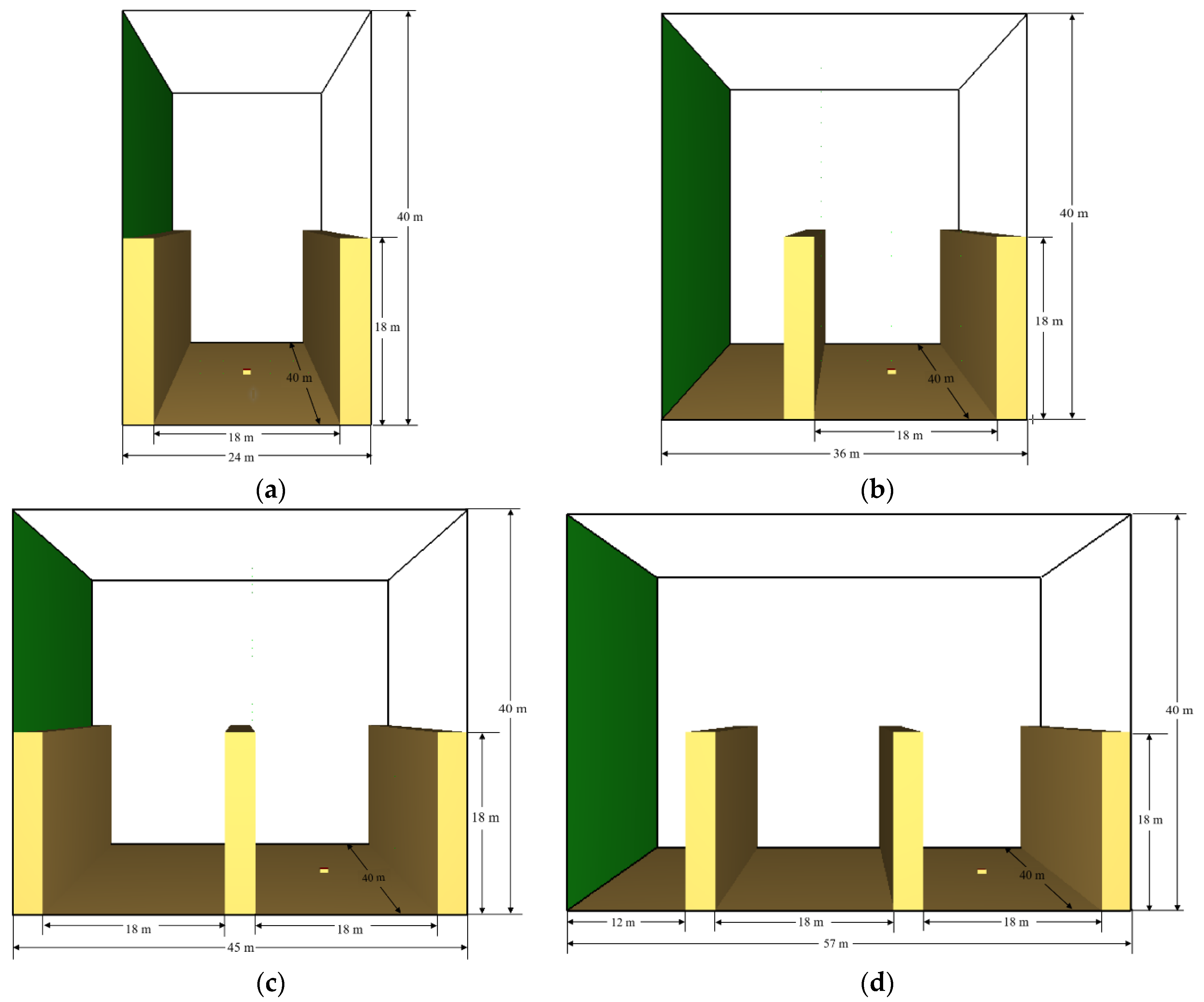
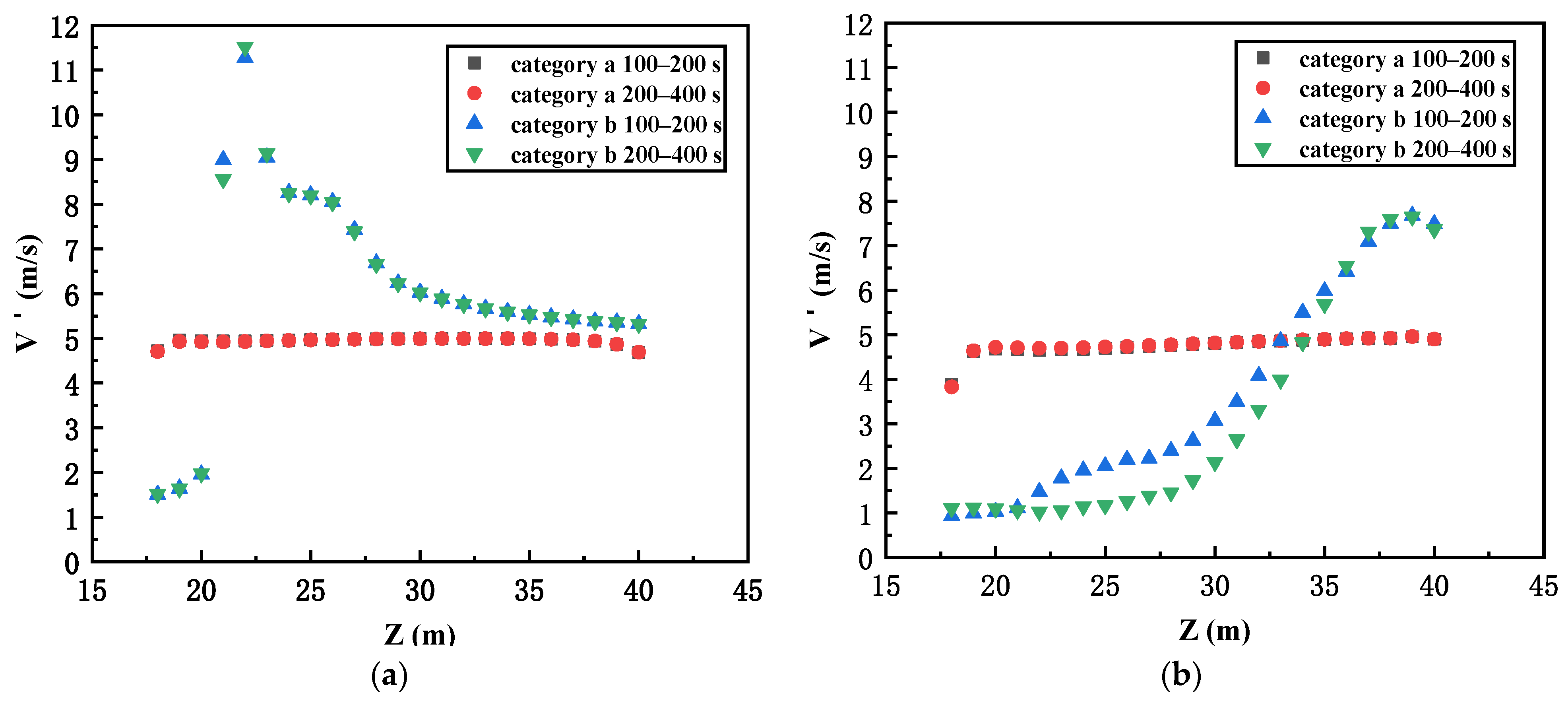

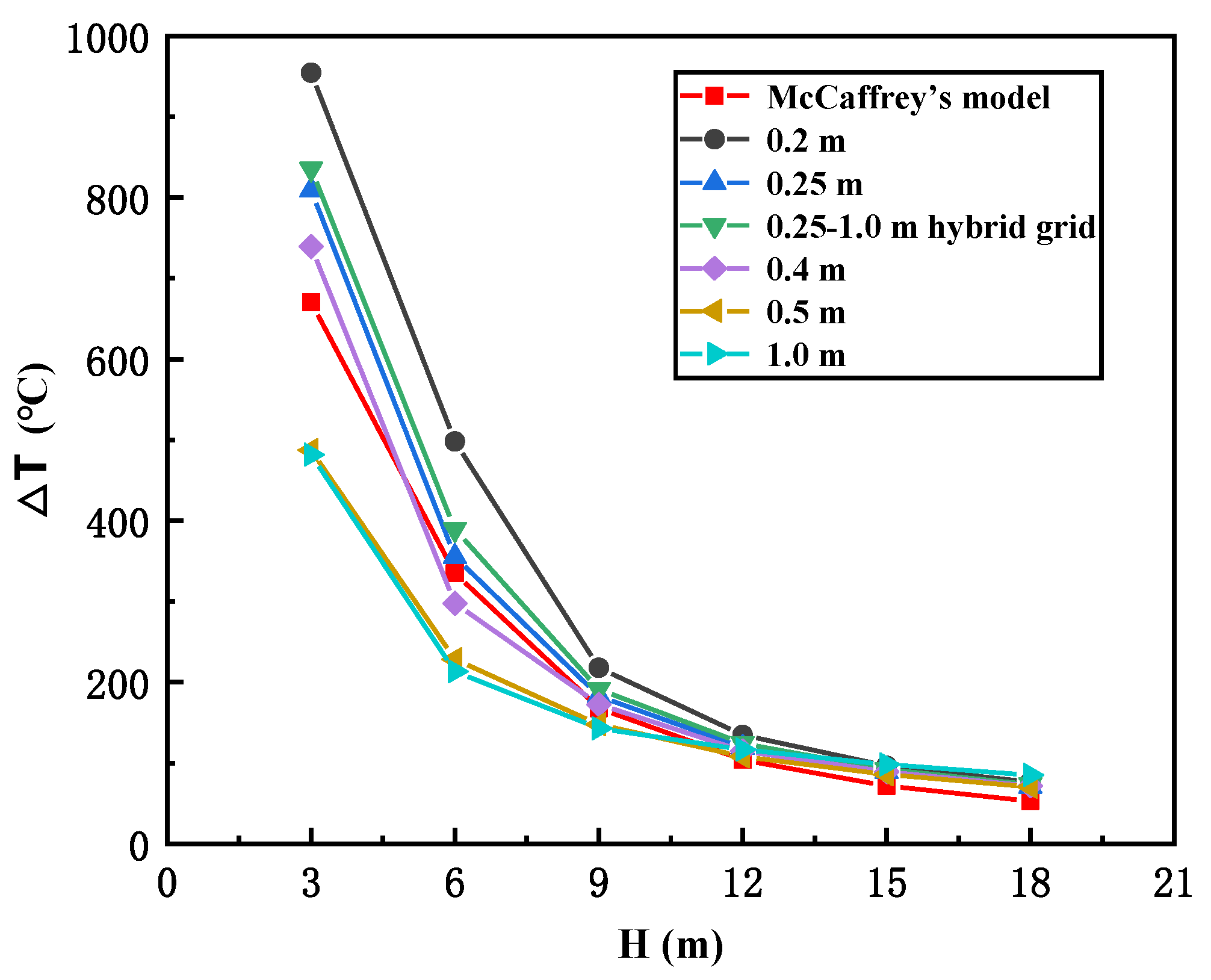
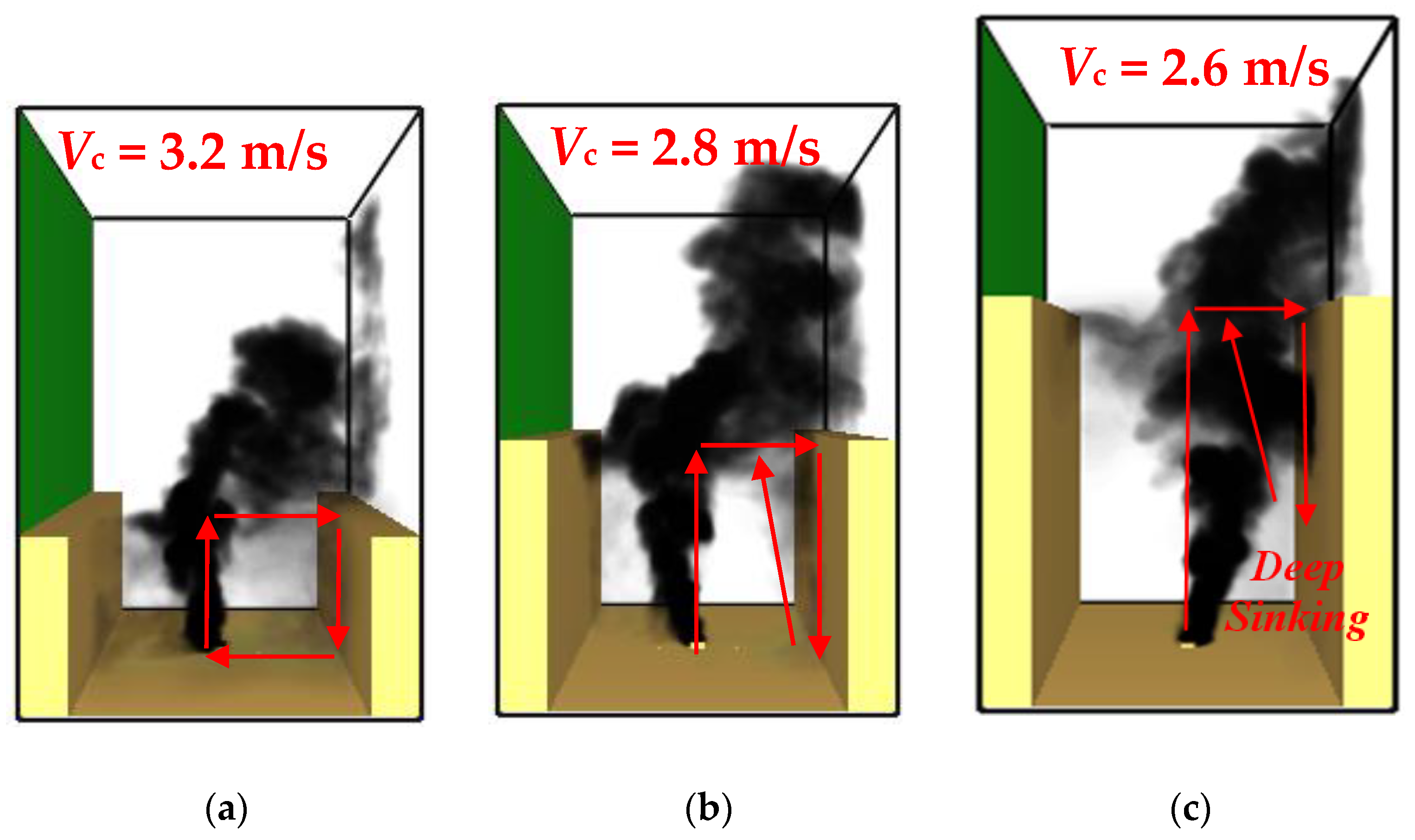


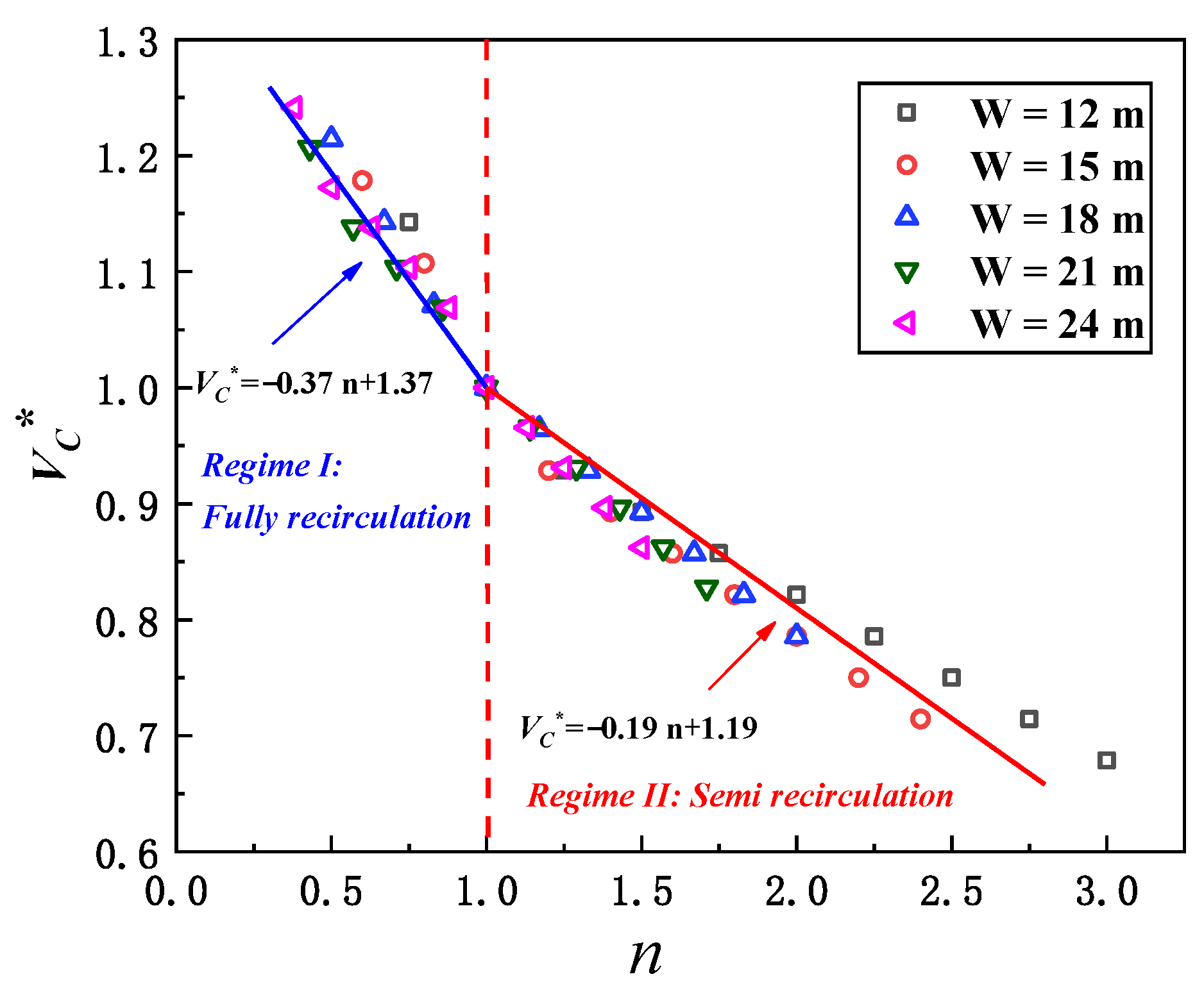
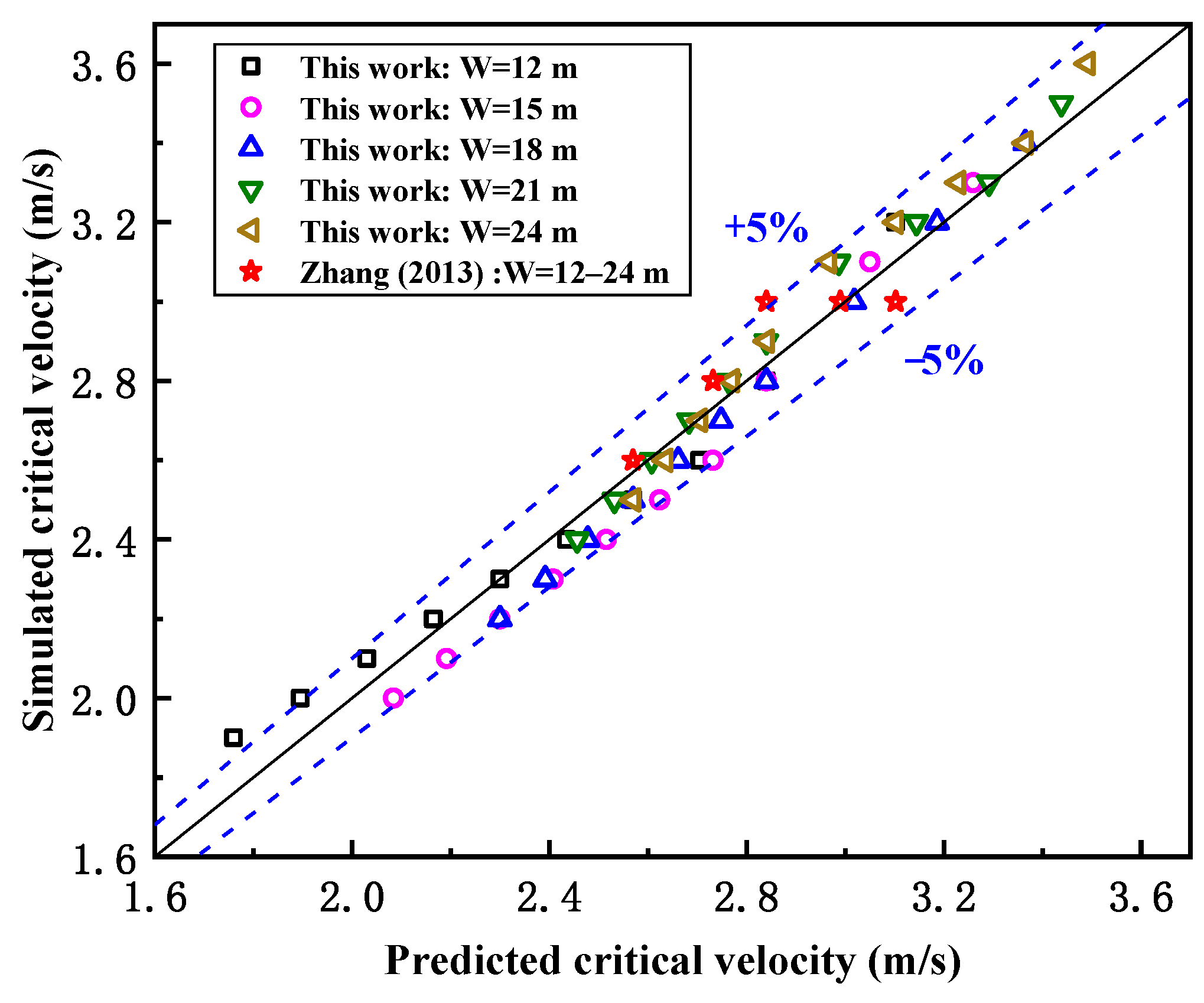
| Test No. | Street Canyon Configurations (Length: L = 40 m) | ||||||||||
|---|---|---|---|---|---|---|---|---|---|---|---|
| W | H | ||||||||||
| 1–10 | 12 m | 9 m | 12 m | 15 m | 18 m | 21 m | 24 m | 27 m | 30 m | 33 m | 36 m |
| n = H/W | 0.75 | 1.00 | 1.25 | 1.50 | 1.75 | 2.00 | 2.25 | 2.50 | 2.75 | 3.00 | |
| 11–20 | 15 m | 9 m | 12 m | 15 m | 18 m | 21 m | 24 m | 27 m | 30 m | 33 m | 36 m |
| n = H/W | 0.60 | 0.80 | 1.00 | 1.20 | 1.40 | 1.60 | 1.80 | 2.00 | 2.20 | 2.40 | |
| 21–30 | 18 m | 9 m | 12 m | 15 m | 18 m | 21 m | 24 m | 27 m | 30 m | 33 m | 36 m |
| n = H/W | 0.50 | 0.67 | 0.83 | 1.00 | 1.17 | 1.33 | 1.50 | 1.67 | 1.83 | 2.00 | |
| 31–40 | 21 m | 9 m | 12 m | 15 m | 18 m | 21 m | 24 m | 27 m | 30 m | 33 m | 36 m |
| n = H/W | 0.43 | 0.57 | 0.71 | 0.86 | 1.00 | 1.14 | 1.29 | 1.43 | 1.57 | 1.71 | |
| 41–50 | 24 m | 9 m | 12 m | 15 m | 18 m | 21 m | 24 m | 27 m | 30 m | 33 m | 36 m |
| n = H/W | 0.38 | 0.50 | 0.63 | 0.75 | 0.88 | 1.00 | 1.13 | 1.25 | 1.38 | 1.50 | |
| Global condition | HRR: 5 MW; Ambient: 20 °C; Wind velocity: from 1.9–3.6 m/s, with intervals by 0.1 m/s | ||||||||||
Publisher’s Note: MDPI stays neutral with regard to jurisdictional claims in published maps and institutional affiliations. |
© 2022 by the authors. Licensee MDPI, Basel, Switzerland. This article is an open access article distributed under the terms and conditions of the Creative Commons Attribution (CC BY) license (https://creativecommons.org/licenses/by/4.0/).
Share and Cite
Xiang, Y.; Lu, K.; Wang, J.; Ding, Y.; Mao, S. Numerical Simulation of the Smoke Recirculation Behavior in Street Canyons with Different Aspect Ratios and Cross-Wind Conditions. Int. J. Environ. Res. Public Health 2022, 19, 7056. https://doi.org/10.3390/ijerph19127056
Xiang Y, Lu K, Wang J, Ding Y, Mao S. Numerical Simulation of the Smoke Recirculation Behavior in Street Canyons with Different Aspect Ratios and Cross-Wind Conditions. International Journal of Environmental Research and Public Health. 2022; 19(12):7056. https://doi.org/10.3390/ijerph19127056
Chicago/Turabian StyleXiang, Yanqing, Kaihua Lu, Jie Wang, Yanming Ding, and Shaohua Mao. 2022. "Numerical Simulation of the Smoke Recirculation Behavior in Street Canyons with Different Aspect Ratios and Cross-Wind Conditions" International Journal of Environmental Research and Public Health 19, no. 12: 7056. https://doi.org/10.3390/ijerph19127056
APA StyleXiang, Y., Lu, K., Wang, J., Ding, Y., & Mao, S. (2022). Numerical Simulation of the Smoke Recirculation Behavior in Street Canyons with Different Aspect Ratios and Cross-Wind Conditions. International Journal of Environmental Research and Public Health, 19(12), 7056. https://doi.org/10.3390/ijerph19127056









